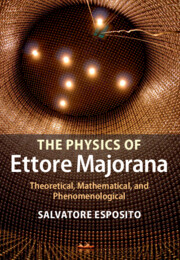Book contents
- Frontmatter
- Contents
- Acknowledgments
- Part I Introducing the character
- Part II Atomic physics
- 3 Two-electron problem
- 4 Thomas–Fermi model
- Part III Nuclear and statistical physics
- Part IV Relativistic fields and group theory
- Part V Quantum field theory
- Part VI Fundamental theories and other topics
- Part VII Beyond Majorana
- Appendix Molecular bonding in quantum mechanics
- References
- Author index
- Subject index
3 - Two-electron problem
Published online by Cambridge University Press: 18 December 2014
- Frontmatter
- Contents
- Acknowledgments
- Part I Introducing the character
- Part II Atomic physics
- 3 Two-electron problem
- 4 Thomas–Fermi model
- Part III Nuclear and statistical physics
- Part IV Relativistic fields and group theory
- Part V Quantum field theory
- Part VI Fundamental theories and other topics
- Part VII Beyond Majorana
- Appendix Molecular bonding in quantum mechanics
- References
- Author index
- Subject index
Summary
Majorana was involved in studying helium on at least two occasions, as we have seen in Chapter 2, namely for his papers N.2 and N.3 published in 1931. However, in his unpublished personal study [17] and research [18] notes we find several additional interesting results and methods directly related to the basic two-electron problem, dating back to 1928–9, some of which are apparently preliminary studies for his published papers (especially paper N.3). The theoretical contributions and numerical calculations, including empirical relations, contained in those notes were largely deduced by making recourse to novel methods not yet in the literature (both of that time and in present day studies), and while part of those numerical results were (and are) inaccurate when compared with the experimental data, the novel methods are nevertheless quite useful in the frontier research related to atomic and nuclear physics [169].
A long-lasting success for quantum mechanics
Following the discovery of the atomic nucleus [170], in 1913 Bohr succeeded [171, 172, 173] in explaining the energy levels of the hydrogen atom in terms of quantization of the action for the classical Kepler orbits. Numerous attempts were then explored to explain the ground state of helium by quantizing different two-electron periodic orbits in a similar manner, but without success. For example, Bohr first discussed a simple model where both electrons in the helium atom move along the same circular orbit and are located at the opposite ends of a diameter [171, 172, 173]. This followed the 1904 proof by the Japanese physicist Hantaro Nagaoka [174, 175] (obviously in the framework of classical mechanics) that such motion is mechanically stable (for sufficiently large attractive forces) and realizes the lowest possible energy. In general, the attempts to quantize the helium atom in the Bohr–Sommerfeld theory [176, 177] were always based on the assumptions that the ground state is related to a single periodic orbit of the electron pair, and that the electrons move on symmetric orbits with equal radii at all times.
- Type
- Chapter
- Information
- The Physics of Ettore MajoranaTheoretical, Mathematical, and Phenomenological, pp. 63 - 82Publisher: Cambridge University PressPrint publication year: 2014



